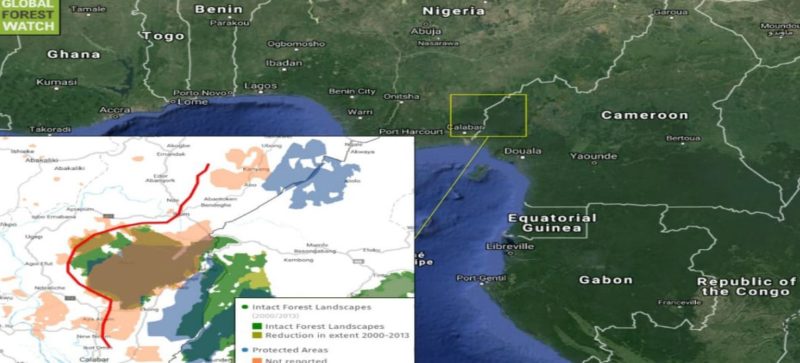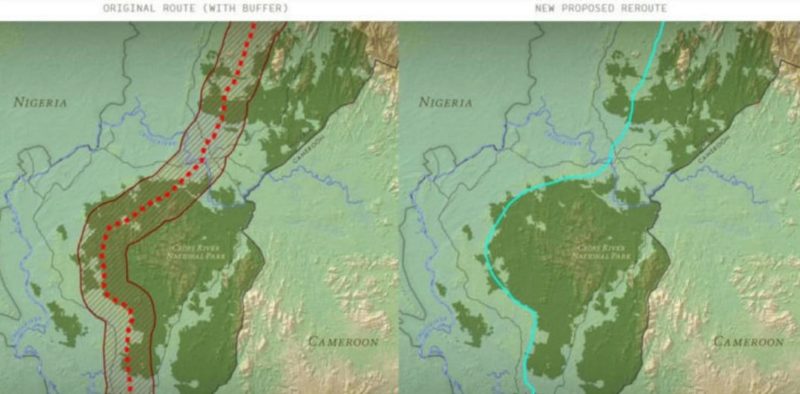Adeniyi Karunwi, Director General of the Nigerian Conservation Foundation (NCF), in this treatise expresses concern over the fact that a remarkable rainforest ecosystem in the country is threatened, courtesy of the proposed Superhighway project in Cross River State. He suggests that the state government appears not to be doing enough to address a set of conditions to be fulfilled before project commencement

still cut through intact forest and protected area
Cross River Tropical Rainforest, the largest remaining rainforest ecosystem in Nigeria and one of the 25 biodiversity hotspots in the world is facing a very serious threats of degradation on account of the proposed Superhighway project of the Cross River State Government.
This rich forest estate is serving as home to highly threatened species including 1,568 plant species of which 77 are endangered medicinal plants and orchids, 22 primate species such as the Cross River gorilla (with only about 300 individuals remaining in the wild), Nigeria-Cameroon chimpanzee, drill monkeys, and a range of other wildlife species facing one of the greatest conservation challenges of our time.
Recent policy direction of the Cross River State Government has given consent for the unprecedented destruction of pristine forest habitats for the construction of the Superhighway. Consequently, dozens of earthmovers have been sighted in forest reserves and community forests making permanent and irreversible alterations to the rich forest landscape of Bakassi, Akamkpa, Ikom, Boki, and Bekwara Local Government Areas (LGAs). Sadly, this action is aggravating widespread poverty and ultimately resulting in untold hardship among indigenous communities that live adjacent to these forests. Essentially, this unplanned and unsustainable developmental action of government pertaining to habitat destruction as well as ecological and species destabilisation, is generating deep environmental and socio-economic concerns among civil society groups, local communities and other stakeholders.
The initiation of government programmes for the development of the State is highly commendable particularly in the context of the Superhighway project. It is however advisable that such large scale projects should be made to comply with all related municipal legislations; international treaties and conventions of which Nigeria is a signatory. Importantly, this should include being subjected to environmental and social impact studies as stipulated in the Environmental Impact Assessment Act of 1992. This law makes it mandatory for proponents (including the Federal, State and Local Governments as well as private developers) to carry out detailed EIA studies on projects with potential impacts on the environment. Reports from such studies must be published for public scrutiny and comments.

It is pertinent to observe that the proposed Superhighway has already produced three failed Environmental Impact Assessment reports. These reports have been widely criticised as being substandard, fraudulent and non-compliant with National Laws and International best practices. Curiously, in a letter dated 29th July, 2017, the 4th version of the EIA report has been granted conditional approval by the Federal Ministry of Environment despite these obvious deficiencies. According to the said letter issued by the Ministry to the proponent – the Cross River State Government, it is expected to fulfil 23 conditions within a period of two weeks before the commencement of the project.
Amongst these conditions are: the payment of compensation to all affected persons and communities, the production of coordinates, surveys and maps of the pathway of the superhighway that is said to have been rerouted from the Cross River National Park and the Ekuri forest; as well as the gazetting of the Reversal Order pertaining to the 10 km span buffer zone on either side of the superhighway previously contemplated; etc. This development has triggered widespread public debate as to whether the Cross River State Government should embark on this project or upgrade the already existing federal highway to a superhighway.
Nevertheless, this whole episode brings to bare some level of suspicion especially when the Cross River State Government on February 20, 2017 issued a notice to the Federal Government of Nigeria about going ahead with the Superhighway with or without the approval of the EIA and, in addition, where many trees felled along the route during the land clearing process were converted to valuable timber and mysteriously disappeared leaving doubts in the minds of many.
Recently, there have been publications and sketches of maps produced on the alternative Superhighway routes. However, the Government is yet to come up with a new acquisition order to show the new route, which would require further EIA. Therefore, “the project to save not just CRNP and Ekuri forest but the entire forest area of Cross River State should be a Flagship project and a state of emergency declared on the Cross River Tropical High Forest”.
Incidentally, in April 2017, the Cross River State Government decided to announce the rerouting of the superhighway following recommendations by some environmental groups, with the excuse that the road was going to be diverted completely from the park. But, as seen from the map above, the highway will still cut through several protected forests reserves and abut the western boundary of the Cross River National Park.
The issues raised in the previous EIA report which have not been adequately addressed in the recently released report are as follows:
- Consistent and correct baseline data;
- Cost-benefit analysis for each of the routes proposed and a clear justification for the superhighway and reasons for building a new road as opposed to upgrading the existing highway;
- The impacts of the superhighway on nearby protected areas namely Cross River National Park, Afi Mountain Wildlife Sanctuary, Afi River Forest Reserve, Ukpon River Forest Reserve and Cross River South Forest Reserve;
- Extensive stakeholder engagement to meet accepted standards as outlined by both Nigerian legislation and international best practice;
- Mitigation measures and sufficient detail for implementation;
- Mention the presence of many rare and endangered species present within the area such as the Preuss’s red colobus monkey Procolobus preussi and the slender-snouted crocodile Mecistops cataphractus both of which are classified by the International Union for the Conservation of Nature (IUCN) as Critically Endangered, or to assess possible impacts;
- The socio-economic study to focus on about 180 affected communities rather than the 21 communities documented. The full impact of the project on these communities, on their livelihoods and vulnerability must also be assessed;
- The 23 conditions for provisional approval (short, medium and long term) given by the Federal Ministry of Environment.
These, and many more issues highlighted above, demonstrate the fact that “the threat still stands”.
